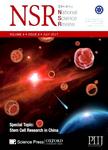Constraints on crustal compositional architecture across the North China-Altaids transition and implications for craton margin reworking
作者机构:Sino Probe CenterChinese Academy of Geological Sciences Key Laboratory of Deep-Earth DynamicsMinistry of Natural Resources Institute of Geology Chinese Academy of Geological Sciences School of Earth Sciences and Engineering Sun Yat-sen University Key Laboratory of Marine Geology and Environment Institute of OceanologyChinese Academy of Sciences China Geological Sample Information CenterChina Geological Survey
出 版 物:《National Science Review》 (国家科学评论(英文版))
年 卷 期:2024年第11卷第5期
页 面:121-133页
核心收录:
学科分类:070904[理学-构造地质学] 0709[理学-地质学] 07[理学]
基 金:supported by the National Natural Science Foundation of China (42074106 and 91962110) the National Key R&D Plan of China (2023YFF0803302)
主 题:North China Craton Altaids crustal composition receiver function joint inversion continental reworking
摘 要:The phase of secular evolution of continents is manifested as the degree of compositional differentiation,modification and maturation of continental crusts, which is vital in understanding the mechanism of continental evolution but is difficult to quantify. Here we use integrated passive-and active-source seismic profiling to conduct joint analysis and inversion and derive Vs and Vp/Vs section models across the North China Craton(NCC) to southeastern Altaids boundary zone that bears a tectonic transition from a reworked ancient craton margin to a Phanerozoic accretionary orogen. We systematically exploited the imaged multiple physical properties as precise and delicate proxies to constrain the compositional architecture in the crust across this important tectonic transition subject to various crustal evolutional phases. Our Vs and Vp/Vs imaging, together with the existing isotopic data, characterizes the Yin Shan–Yan Shan belt as the northern NCC margin with layered homogeneous compositions that point to an evolved crust. However, the lower-crustal low-Vs/high-Vp/Vs signature that overlaps the shallowly dipping to horizontal reflective fabrics suggests that the crust of the northern NCC margin has undergone considerable reworking through lower-crustal-stretching-assisted melt migration and mixing since the late Paleozoic to Mesozoic eras. The process probably involved crust–mantle interaction and thus resulted in a compositionally modified ancient crustal basement. On the contrary, the southeastern Altaids domain manifests crustal complexity in compositions and structures inferred to be indicative of a juvenile crust of the Phanerozoic accretionary orogen. Our results provide deep physical-property constraints that shed new light on the crustal evolution of a complex craton margin.



